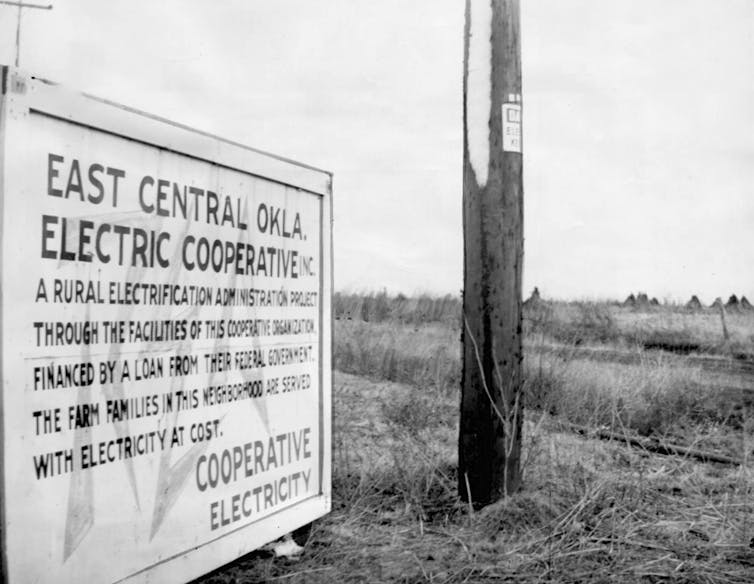Maine voters don't like their electric utilities, but they balked at paying billions to buy them out
Power companies can be publicly or privately owned and may report to corporate boards, local governments or co-op members. But there’s no one best way to deliver electricity reliably and affordably.
Frustration with electric utilities is universal today. Whether it’s concerns over high rates, poor service or a combination of both, people are constantly looking for a better answer to the systems that serve them.
In the Nov. 7, 2023, election, voters in Maine had a chance to consider a new model for electricity service that would replace the state’s two widely unpopular private utilities, but they balked in the face of multibillion-dollar cost projections.
This decision took the form of two ballot questions. Question 3 asked whether voters wanted to create a new publicly owned power company, dubbed Pine Tree Power, to take over the existing assets of Maine’s two privately owned utilities. The related Question 1 asked whether consumer-owned electric utilities should have to get public approval before taking on more than US$1 billion in debt. Voters adopted Question 1 and soundly defeated Question 3.
Municipal ownership of utilities is not new: Across the U.S., about 2,000 communities have public power utilities. In Nebraska, all electricity providers are publicly owned.
But private utilities often fight against public takeover attempts – and Maine was no exception. The parent companies of Central Maine Power and Versant Power spent nearly $40 million campaigning against the ballot measures, compared with $1.2 million on the pro-public power side.
At the University of Florida’s Public Utility Research Center, I work with utilities and regulators around the world to assess different ways of structuring power companies. Questions about what kinds of utilities best serve the public have intensified in recent years. As the Maine vote shows, people want different and sometimes competing things from their utility systems.
Three basic structures
There are three basic ownership models for electric utilities. Investor-owned utilities, or IOUs, are owned by private shareholders, who might live next door or halfway around the world. Their stock is publicly traded, and their CEOs have a fiscal responsibility to shareholders as well as to serve their customers.
Municipally owned utilities, often known as munis, are owned locally, generally by the government of the city they serve. Some municipal utilities also serve customers in surrounding areas.
Cooperative utilities are owned entirely by their customers, much like housing or food co-ops. Initially, cooperatives tended to be located in more rural zones. Some of these areas, such as southwest Florida, have grown so rapidly that the term “rural cooperative” no longer applies.
Both munis and cooperatives operate as nonprofits. There is no consistent nationwide link between rates and ownership structure, but it is notable that five of the nine municipal and cooperative utilities in Maine charge less then 15 cents per kilowatt-hour for residential customers, compared with 27 to 30 cents for Central Maine Power and Versant. This may have influenced voters’ perception that a municipal utility could provide power at lower prices.
Municipal utilities do return a portion of their revenues to their investors, but a muni’s investor is the city it serves. According to the American Public Power Association, in 2020, public power utilities returned a median of 6.1% of their revenues to the communities they served. This return allows local governments to keep taxes lower than would otherwise be necessary to provide government services.
These utilities are also regulated in different ways. Investor-owned utilities are regulated by state public utility commissions, which oversee everything from what kinds of facilities to build and where to build them to how to reflect those costs in electricity rates.
Municipally owned and cooperative utilities are typically regulated on a limited basis by state public utility commissions – usually on matters of safety, reliability or the utilities’ impacts on the rest of the grid. Responsibility for municipal utility rates lies with either the city council or an independent local utility board. Cooperative utilities typically set their rates through a board elected by their customers.
Maine’s approach
The structure proposed in Maine was a fascinating hybrid case. Pine Tree Power’s ownership would have closely mirrored that of a municipal utility, governed by a board, but its rates would have been regulated by the Maine Public Utilities Commission. It is unclear what the board’s responsibilities would have been.
Further, since the public utility commission would have been required to set rates according to the actual costs of providing service, it is unclear whether Pine Tree Power would have been allowed to charge rates sufficient to return revenue to the state, similar to what most municipal utilities do.
There was intense debate about Pine Tree Power’s potential benefits. One study showed that shifting from private to public power would produce significant benefits, while another showed significant costs. A third study forecast long-term benefits but short-term costs, primarily from buying out the state’s two private utilities.

In a municipalization, the cost to buy out the private utility strongly influences how much net benefit will result – and it’s not as simple as writing a check for the book value of the assets. Typically, price determination is a quasi-judicial process overseen by an arbitrator.
For example, when Winter Park, Florida, took control of the local assets of its power provider in 2005, the city estimated the value of the physical assets at $15.8 million. The eventual purchase price determined by an arbitrator was just over $42 million. The city also incurred legal and technical support costs. Winter Park issued almost $49 million in bonds to cover all of the costs of the acquisition.
Maine’s cost safeguard
One curious element of the Maine vote that could have future impacts is the voter approval process under Question 1, which was adopted. Typically, when a community municipalizes its electric power, voters would consider an initial referendum authorizing the government to explore the possibility of purchasing the private utility’s assets, and then a second referendum when the costs of the purchase were known.
The second vote would be more specific – something like, “Should the City issue bonds in the amount of $200 million to finalize the purchase of the assets of XYZ Corp. for the express purpose of establishing a municipal utility?”
This approach is expensive to administer, since it requires two votes, and a defeat at either stage can stop the acquisition process. But it also safeguards voters, since it ensures that they have information about how much municipalizing their utility will cost before they vote to approve it.
Cost estimates for buying out Maine’s utilities and creating Pine Tree Power ranged from $5 billion to $13.5 billion, and buyout opponents – including Maine Gov. Janet Mills – strongly emphasized the potential price tag. However, the fact that voters approved Question 1 might actually make a future municipalization vote more likely to pass, since voters now know they will have a safeguard of knowing the purchase price prior to their final approval.
Ultimately, in my view, there is no best model for utility ownership and operation. One strength of private utilities is that they are subject to clear, consistent oversight by professional utility regulators. For their part, municipal and cooperative utilities offer local control and greater flexibility to address local concerns. However, all types of power companies face daunting challenges, including grid cybersecurity, the clean energy transition and hiring and retaining skilled workers.
As I see it, a community’s best strategy is to choose a model that has strengths residents value, and whose weaknesses are less important or can be mitigated in other ways. While Maine voters may not love the system they have, their fear of the unknown was apparently stronger.
Theodore Kury is the Director of Energy Studies at the University of Florida’s Public Utility Research Center, which is sponsored in part by the Florida electric and gas utilities and the Florida Public Service Commission. In 2018, he was principal investigator on a grant from the Jessie Ball duPont Fund to study the value of municipal utilities in a changing marketplace. That work informs portions of this piece. However, the Center maintains sole editorial control of this and any other work.
Read These Next
The world risks forgetting one of humanity’s greatest triumphs as polio nears global eradication − 7
Polio may finally be defeated in the next 5 years. Will the world recognize what an extraordinary achievement…
Autocracies in transition: In 2025, Cameroon and Tanzania rulers clung to power — but look more vuln
The countries, whose respective leaders recently won widely disputed elections, offer contrasting examples…
Why are some Black conservatives drawn to Nick Fuentes?
Black Americans and white nationalists have joined forces in the past. And a number of cultural and…






